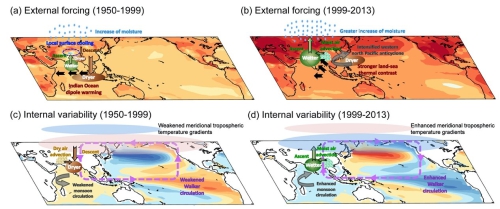Scientists Decode Why India Faced 5-decade Long Rainfall Decline
Date:2020-06-11
A billion people rely on rainfall from the Indian summer monsoon (ISM). Its variability consequently produces impacts that frequently cause massive disruption, both locally, through extreme events for example, but also remotely via its effect on the global prices of commodities such as rice. Understanding the variability is thus essential if adaptation planning for future events is to be effective.
The variability manifested itself in a decline in monsoon rainfall over north central India starting in the 1950s which persisted for as long as 5 decades before a reversal from 1999 onwards. Nailing down the predominant reasons for the decline and recovery has been a task that has been vexing scientists ever since.
As part of international collaboration with scientists in British and American universities, Dr HUANG Xin and Prof. ZHOU Tianjun of the Institute of Atmospheric Physics at the Chinese Academy of Sciences have been examining the issue more closely, using data provided by the UK Met Office and Germany's Max Planck Institute. Results, now published in the Journal of Climate have examined the differing trends in pre- and post-2000 ISM rainfall. "We found that neither the five-decade long decline before 2000 or subsequent increase can be solely explained as a response to external climate forcing," explained Huang, "Instead, we have demonstrated the crucial role of natural variability."
Here, external forcing includes changes in greenhouse gases, anthropogenic aerosols, and land use etc. Natural variability refers to variations in the mean state due to internal processes within the climate system. They are often regarded as "signal" and "noise" in climate studies, respectively.
"Increasing greenhouse gas concentrations in the atmosphere generally tend to increase rainfall over India. Up to the year 2000 however, it appears that the natural variability has been able to override this effect, resulting in the overall decrease." Said HUANG, "In addition to anthropogenic climate change, rainfall changes in recent decades are also influenced by natural sea surface temperature oscillation over Pacific basin."
The prominent natural variability in Pacific sea surface temperature on decadal-multidecadal timescales is usually described as the Interdecadal Pacific Oscillation (IPO). Positive IPO phases are characterized by a warmer than normal sea surface in the tropical central-eastern Pacific and cooler than normal conditions outside of the tropics with an opposite pattern during negative IPO phases.
The scientists found that the differing phases of the IPO played subtle, but crucial supplementary roles in the recent interdecadal variations of the ISM rainfall. Fluctuations in the IPO induce anomalous thermal contrasts between the north and south and changes to ascent and descent throughout the region. These, in turn, result in changes to the horizontal advection, from the west and east, of moisture into India.
Before 2000, the observed negative-to-positive IPO phase transition appears to have decreased the externally forced rainfall trend. After 2000, the accumulative impact of external forcing and the positive-to-negative IPO transition has contributed to the observed wetting trend. The combined influences of the external forcing and IPO explain the observed rainfall changes. "This suggests, besides the forced 'signal', that we can actually extract useful information from the apparent, natural 'noise'," added HUANG.
The study supports, and brings together, for the first time, many of the different explanations that have been proposed in previous studies.

Schematic diagrams showing how external forcing and internal variability affect the recent decline and recovery of ISM rainfall, respectively.
"Going forward, the study emphasizes the importance of robust, reliable handling, and indeed prediction, of the IPO in climate models, to ensure that projections of future ISM climate, are suitable for use by policy makers," added Prof. ZHOU.
Reference
Xin Huang, Tianjun Zhou*, Andrew Turner, Aiguo Dai, Xiaolong Chen, Robin Clark, Jie Jiang, Wenmin Man, James Murphy, John Rostron, Bo Wu, Lixia Zhang, Wenxia Zhang, Liwei Zou (2020) The Recent Decline and Recovery of Indian Summer Monsoon Rainfall: Relative Roles of External Forcing and Internal Variability. Journal of Climate, 33(12): 5035–5060. doi: 10.1175/JCLI-D-19-0833.1. https://journals.ametsoc.org/doi/10.1175/JCLI-D-19-0833.1
Media contact: Ms. LIN Zheng, jennylin@mail.iap.ac.cn
